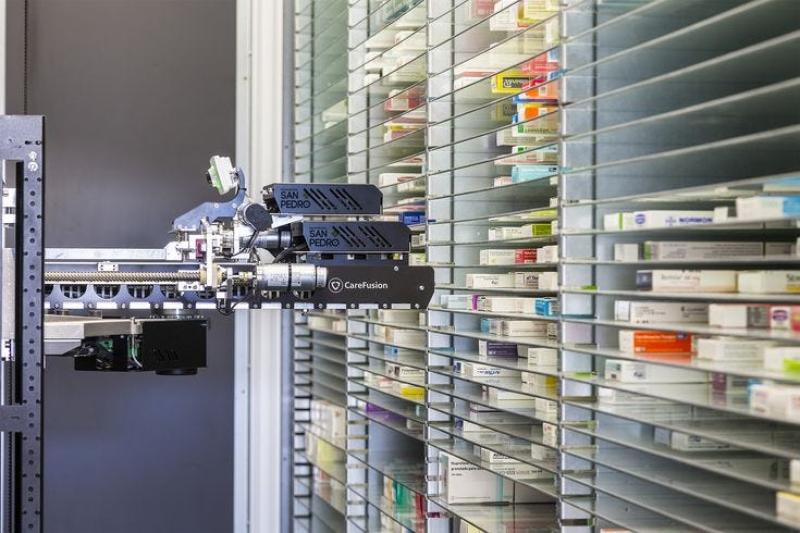Pharmacy Automation Market to Reach $12.1 Billion by 2032 Amid AI-Driven Transformation
The pharmacy automation industry is witnessing significant advancements, propelled by the growing need to enhance operational efficiency and reduce medication errors. Enhanced integration of robotics and AI-driven systems is reshaping workflows across hospitals and retail pharmacies, manifesting strong market dynamics and business growth. Insights into market drivers and restraints reveal evolving market opportunities and challenges that are critical for strategic planning.
Market Size and Overview
The Global Pharmacy Automation Market size is estimated to be valued at USD 6.85 billion in 2025 and is expected to reach USD 12.1 billion by 2032, exhibiting a compound annual growth rate (CAGR) of 8.3% from 2025 to 2032.
This Pharmacy Automation Market Growth reflects increasing adoption of automated dispensing systems and intelligent storage solutions across healthcare settings worldwide. The robust market revenue growth is underpinned by rising demand for reducing medication errors and improving patient safety, factors well documented in recent market research reports. The evolving market scope includes expanding applications in hospital pharmacies and community pharmacies driven by regulatory compliance and operational efficiency imperatives.
Key Takeaways
- Dominating Region: North America remains the dominating region in 2025 due to its advanced healthcare infrastructure and stringent regulatory policies enhancing pharmacy automation adoption.
- Fastest Growing Region: Asia Pacific is the fastest-growing region in pharmacy automation market size, propelled by healthcare digitization initiatives and rising healthcare expenditure in countries like India and China.
- Segment Categories:
- Product Type: Automated Dispensing Cabinets dominate due to their widespread application in hospitals, with Automated Storage and Retrieval Systems growing fastest; recent deployment in leading US hospitals like Mayo Clinic highlights this trend.
- End User: Hospital pharmacies hold dominance driven by complex medication workflows, while retail pharmacies are fastest-growing segments, witnessing adoption of compact, space-efficient automation units exemplified by recent installations by major retail chains in Japan.
- Technology: Robotics-based automation leads in market revenue, with AI-powered dispensing solutions growing rapidly, as evidenced by innovative product launches in 2024 integrating machine learning for inventory management.
Market Key Trends
A defining trend shaping the pharmacy automation market is the integration of artificial intelligence and machine learning to enhance medication dispensing accuracy and inventory control. In 2024, a prominent market company launched an AI-enabled pharmacy robot that reduced dispensing errors by over 30%, demonstrating tangible impact on operational efficiency. This trend is supported by increasing market insights emphasizing the convergence of IoT devices with pharmacy automation for real-time monitoring and predictive maintenance, reducing downtime and improving service quality. Moreover, healthcare regulatory bodies in North America and Europe are enforcing stricter compliance around medication safety, encouraging wider adoption of these advanced technologies. This technological shift drives not only market growth but also expands the market scope, as intelligently automated systems address significant market challenges such as errors, theft, and manual handling inefficiencies, supported by recent market analysis.
Key Players
Significant companies operating in the pharmacy automation market include Swisslog Healthcare, Omnicell, Inc., BD, Oracle, Capsa Healthcare, McKesson Corporation, Yuyama Co., Ltd., Gebr. Willach GmbH, ScriptPro LLC., and RxSafe, LLC. These market players have adopted robust market growth strategies such as strategic partnerships and technology innovation to capture market opportunities. For instance, in 2025, one leading player announced an expansion of its AI-driven automation solutions in North America, resulting in improved market revenue streams. Additionally, recent collaborations between robotics firms and software providers have enabled customized automation solutions tailored to hospital and retail pharmacy needs, enhancing market share and competitive positioning. Market companies continue to invest in R&D for smart pharmacy solutions that reduce operational costs and support compliance, as documented in recent market report findings.
FAQs
Q1: Who are the dominant players in the Pharmacy Automation Market?
Dominant players include Swisslog Healthcare, Omnicell, Inc., BD, Oracle, and McKesson Corporation, known for their innovative automation technologies and broad market presence.
Q2: What will be the size of the Pharmacy Automation Market in the coming years?
The market size is projected to grow from USD 6.85 billion in 2025 to approximately USD 12.1 billion by 2032, driven by rising demand for automation in retail and hospital pharmacies.
Q3: Which end-user segment offers the largest growth opportunity in the Pharmacy Automation Market?
Retail pharmacies are emerging as the fastest-growing segment, buoyed by the adoption of compact and efficient automation solutions enhancing service speed and accuracy.
Q4: How will market development trends evolve over the next five years?
Market trends point to increasing integration of AI and IoT in pharmacy automation systems, alongside stricter regulatory compliance, fostering technological innovation and expanded market scope.
Q5: What is the nature of the competitive landscape and challenges in the Pharmacy Automation Market?
The competitive landscape involves key market players adopting growth strategies like partnerships and innovation, with challenges including high initial investment costs and integration complexities.
Q6: What go-to-market strategies are commonly adopted in the Pharmacy Automation Market?
Market companies focus on strategic partnerships, regional expansions, and continuous product innovation to capitalize on emerging market opportunities and address evolving customer needs.
Get This Report In Japanese Language: 薬局自動化市場
Get This Report In Korean Language: 약국 자동화 시장
About Author:
Vaagisha brings over three years of expertise as a content editor in the market research domain. Originally a creative writer, she discovered her passion for editing, combining her flair for writing with a meticulous eye for detail. Her ability to craft and refine compelling content makes her an invaluable asset in delivering polished and engaging write-ups.
(LinkedIn: https://www.linkedin.com/in/vaagisha-singh-8080b91)
